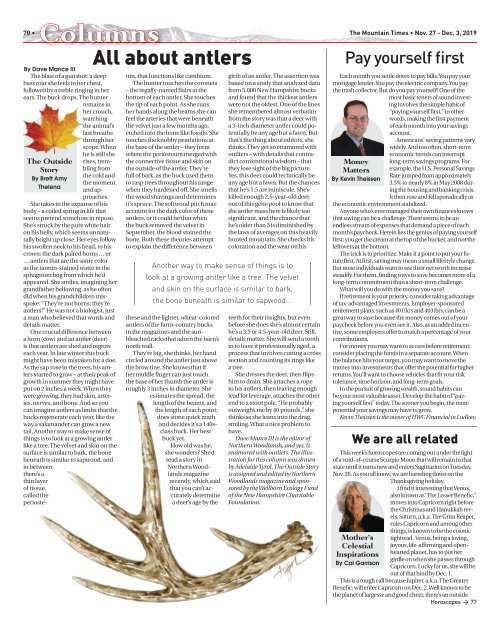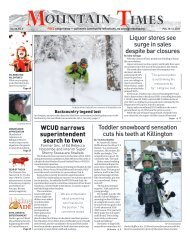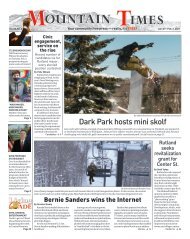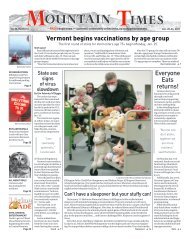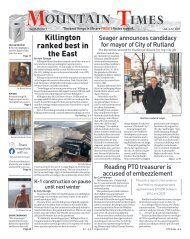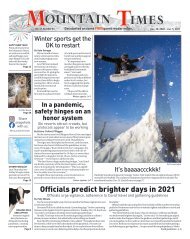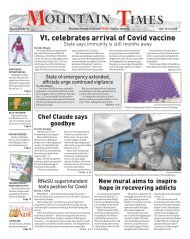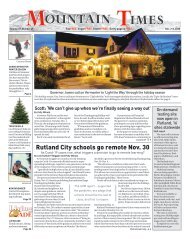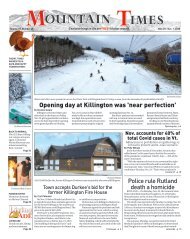Mountain Times - Volume 48, Number 48: Nov. 27-Dec. 3, 2019
You also want an ePaper? Increase the reach of your titles
YUMPU automatically turns print PDFs into web optimized ePapers that Google loves.
Columns<br />
70 • The <strong>Mountain</strong> <strong>Times</strong> • <strong>Nov</strong>. <strong>27</strong> - <strong>Dec</strong>. 3, <strong>2019</strong><br />
By Dave Mance III<br />
The blast of a gunshot: a deep<br />
bass roar she feels in her chest,<br />
followed by a treble ringing in her<br />
ears. The buck drops. The hunter<br />
remains in<br />
her crouch,<br />
watching<br />
the animal’s<br />
last breaths<br />
through her<br />
scope. When<br />
he is still she<br />
The Outside<br />
Story<br />
By Brett Amy<br />
Thelena<br />
rises, bling from<br />
tremthe<br />
cold and<br />
the moment,<br />
and approaches.<br />
All about antlers<br />
She takes in the expanse of his<br />
body – a coiled spring in life that<br />
seems pretend somehow in repose.<br />
She’s struck by the pure white hair<br />
on his belly, which seems unnaturally<br />
bright up close. Her eyes follow<br />
his swollen neck to his head, to his<br />
crown: the dark paired horns … er<br />
… antlers that are the same color<br />
as the tannin-stained water in the<br />
sphagnum bog from which he’d<br />
appeared. She smiles, imagining her<br />
grandfather bellowing, as he often<br />
did when his grandchildren misspoke:<br />
“They’re not horns; they’re<br />
antlers!” He was not a biologist, just<br />
a man who believed that words and<br />
details matter.<br />
One crucial difference between<br />
a horn (cow) and an antler (deer)<br />
is that antlers are shed and regrow<br />
each year. In late winter this buck<br />
might have been mistaken for a doe.<br />
As the sap rose in the trees, his antlers<br />
started to grow – at their peak of<br />
growth in summer they might have<br />
put on 2 inches a week. When they<br />
were growing, they had skin, arteries,<br />
nerves, and bone. And so you<br />
can imagine antlers as limbs that the<br />
bucks regenerate each year, like the<br />
way a salamander can grow a new<br />
tail. Another way to make sense of<br />
things is to look at a growing antler<br />
like a tree. The velvet and skin on the<br />
surface is similar to bark, the bone<br />
beneath is similar to sapwood, and<br />
in between<br />
there’s a<br />
thin layer<br />
of tissue,<br />
called the<br />
periosteum,<br />
that functions like cambium.<br />
The hunter touches the coronets<br />
– the regally-named flairs at the<br />
bottom of each antler. She touches<br />
the tip of each point. As she runs<br />
her hands along the beams she can<br />
feel the arteries that were beneath<br />
the velvet just a few months ago,<br />
etched into the bone like fossils. She<br />
touches the knobby pearlations at<br />
the base of the antler – they form<br />
where the periosteum merged with<br />
the connective tissue and skin on<br />
the outside of the antler. They’re<br />
full of bark, as the buck used them<br />
to rasp trees throughout his range<br />
when they hardened off. She smells<br />
the wood shavings and determines<br />
it’s spruce. The softwood pitch may<br />
account for the dark color of these<br />
antlers, or it could be that when<br />
the buck removed the velvet in<br />
September, the blood stained the<br />
bone. Both these theories attempt<br />
to explain the difference between<br />
these and the lighter, wheat-colored<br />
antlers of the farm-country bucks<br />
in the magazines and the sunbleached<br />
racks that adorn the barn’s<br />
north wall.<br />
They’re big, she thinks, her hand<br />
circled around the antler just above<br />
the brow tine. She knows that if<br />
her middle finger can just touch<br />
the base of her thumb the antler is<br />
roughly 3 inches in diameter. She<br />
estimates the spread, the<br />
length of the beams, and<br />
the length of each point;<br />
does some quick math<br />
and decides it’s a 140sclass<br />
buck. Her best<br />
buck yet.<br />
How old was he,<br />
she wonders? She’d<br />
read a story in<br />
Northern Woodlands<br />
magazine<br />
recently, which said<br />
that you can’t accurately<br />
determine<br />
a deer’s age by the<br />
girth of an antler. The assertion was<br />
based on a study that analyzed data<br />
from 5,000 New Hampshire bucks<br />
and found that the thickest antlers<br />
were not the oldest. One of the lines<br />
she remembered almost verbatim<br />
from the story was that a deer with<br />
a 3-inch diameter antler could potentially<br />
be any age but a fawn. But<br />
that’s the thing about editors, she<br />
thinks. They get so enamored with<br />
outliers – with details that contradict<br />
conventional wisdom – that<br />
they lose sight of the big picture.<br />
Yes, this deer could technically be<br />
any age but a fawn. But the chances<br />
that he’s 1.5 are miniscule. She’s<br />
killed enough 2.5-year-old deer<br />
out of this gene pool to know that<br />
the antler mass here is likely too<br />
significant, and the chance that<br />
he’s older than 5 is diminished by<br />
the laws of averages on this heavily<br />
hunted mountain. She checks his<br />
coloration and the wear on his<br />
Another way to make sense of things is to<br />
look at a growing antler like a tree. The velvet<br />
and skin on the surface is similar to bark,<br />
the bone beneath is similar to sapwood...<br />
teeth for their insights, but even<br />
before she does she’s almost certain<br />
he’s a 3.5 or 4.5-year-old deer. Still,<br />
details matter. She will send a tooth<br />
in to have it professionally aged, a<br />
process that involves cutting a cross<br />
section and counting its rings like<br />
a tree.<br />
She dresses the deer, then flips<br />
him to drain. She attaches a rope<br />
to his antlers, then leaving enough<br />
lead for leverage, attaches the other<br />
end to a stout pole. “He probably<br />
outweighs me by 40 pounds,” she<br />
thinks as she leans into the drag,<br />
smiling. What a nice problem to<br />
have.<br />
Dave Mance III is the editor of<br />
Northern Woodlands, and yes, is<br />
enamored with outliers. The illustration<br />
for this column was drawn<br />
by Adelaide Tyrol. The Outside Story<br />
is assigned and edited by Northern<br />
Woodlands magazine and sponsored<br />
by the Wellborn Ecology Fund<br />
of the New Hampshire Charitable<br />
Foundation.<br />
Pay yourself first<br />
Each month you settle down to pay bills. You pay your<br />
mortgage lender. You pay the electric company. You pay<br />
the trash collector. But do you pay yourself? One of the<br />
most basic tenets of sound investing<br />
involves the simple habit of<br />
“paying yourself first,” in other<br />
words, making the first payment<br />
of each month into your savings<br />
account.<br />
Americans’ saving patterns vary<br />
widely. And too often, short-term<br />
Money<br />
Matters<br />
By Kevin Theissen<br />
Mother’s<br />
Celestial<br />
Inspirations<br />
By Cal Garrison<br />
economic trends can interrupt<br />
long-term savings programs. For<br />
example, the U.S. Personal Savings<br />
Rate jumped from approximately<br />
3.5% to nearly 8% in May 2008 during<br />
the housing and banking crisis.<br />
It then rose and fell sporadically as<br />
the economic environment stabilized.<br />
Anyone who’s ever managed their own finances knows<br />
that saving can be a challenge. There seems to be an<br />
endless stream of expenses that demand a piece of each<br />
month’s paycheck. Herein lies the genius of paying yourself<br />
first: you get the cream at the top of the bucket, and not the<br />
leftovers at the bottom.<br />
The trick is to prioritize. Make it a point to put your future<br />
first. At first, saving may mean a small lifestyle change.<br />
But most individuals want to see their net worth increase<br />
steadily. For them, finding ways to save becomes more of a<br />
long-term commitment than a short-term challenge.<br />
What will you do with the money you save?<br />
If retirement is your priority, consider taking advantage<br />
of tax-advantaged investments. Employer-sponsored<br />
retirement plans, such as 401(k)s and 403(b)s, can be a<br />
great way to save because the money comes out of your<br />
paycheck before you even see it. Also, as an added incentive,<br />
some employers offer to match a percentage of your<br />
contributions.<br />
For money you may want to access before retirement,<br />
consider placing the funds in a separate account. When<br />
the balance hits your target, you may want to move the<br />
money into investments that offer the potential for higher<br />
returns. You’ll want to choose vehicles that fit your risk<br />
tolerance, time horizon, and long-term goals.<br />
In the pursuit of growing wealth, sound habits can<br />
be your most valuable asset. Develop the habit of “paying<br />
yourself first” today. The sooner you begin, the more<br />
potential your savings may have to grow.<br />
Kevin Th eissen is the owner of HWC Financial in Ludlow.<br />
We are all related<br />
This week’s horoscopes are coming out under the light<br />
of a void-of-course Scorpio Moon that will remain in that<br />
state until it turns new and enters Sagittarius on Tuesday,<br />
<strong>Nov</strong>. 26. As you all know, we are barreling down on the<br />
Thanksgiving holiday.<br />
I find it interesting that Venus,<br />
also known as ‘The Lesser Benefic,”<br />
moves into Capricorn right before<br />
the Christmas and Hanukkah revels.<br />
Saturn, a.k.a. The Grim Reaper,<br />
rules Capricorn and among other<br />
things, is known to be the cosmic<br />
tightwad. Venus, being a loving,<br />
joyous, life-affirming and openhearted<br />
planet, has to put her<br />
girdle on when she passes through<br />
Capricorn. Lucky for us, she will be<br />
out of that bind by <strong>Dec</strong>. 1.<br />
This is a tough call because Jupiter, a.k.a. The Greater<br />
Benefic, will enter Capricorn on <strong>Dec</strong>. 2. Well known to be<br />
the planet of largesse and good cheer, there’s an outside<br />
Horoscopes > 77


